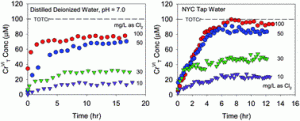Dana Lindsay and colleagues at Manhattan College, USA, have conducted a study to better understand the rate and extent of carcinogenic CrVI generation following the disinfection of drinking water with chlorine. Trace amounts of CrIII may be present in water supplies, but the extent to which this is oxidised to CrVI is poorly understood. Lindsay and colleagues found that oxidation occurred within a matter of hours, and therefore could occur during water treatment plants, but plateaued at less than 100% conversion, even with relatively high doses of chlorine.
Oxidation of CrIII to CrVI during chlorination of drinking water
Dana R. Lindsay , Kevin J. Farley and Richard F. Carbonaro
J. Environ. Monit., 2012, Advance Article
DOI: 10.1039/C2EM00012A
Understanding the fate and transport of engineered nanoparticles in the environment is a key issue, this paper Jeffery Nason et al. have investigated the effect of natural organic matter on the stabilisation of nanoparticles in aquatic environments. Their findings indicate that both the type and concentration of the organic matter, along with the ionic strength of the aquatic system are important factors in determining colloidal nanoparticle stability.
Effects of natural organic matter type and concentration on the aggregation of citrate-stabilized gold nanoparticles
Jeffrey A. Nason , Shannon A. McDowell and Ty W. Callahan
J. Environ. Monit., 2012, Advance Article
DOI: 10.1039/C2EM00005A
Both these papers are free to access for 4 weeks following a simple registration for individual users.










